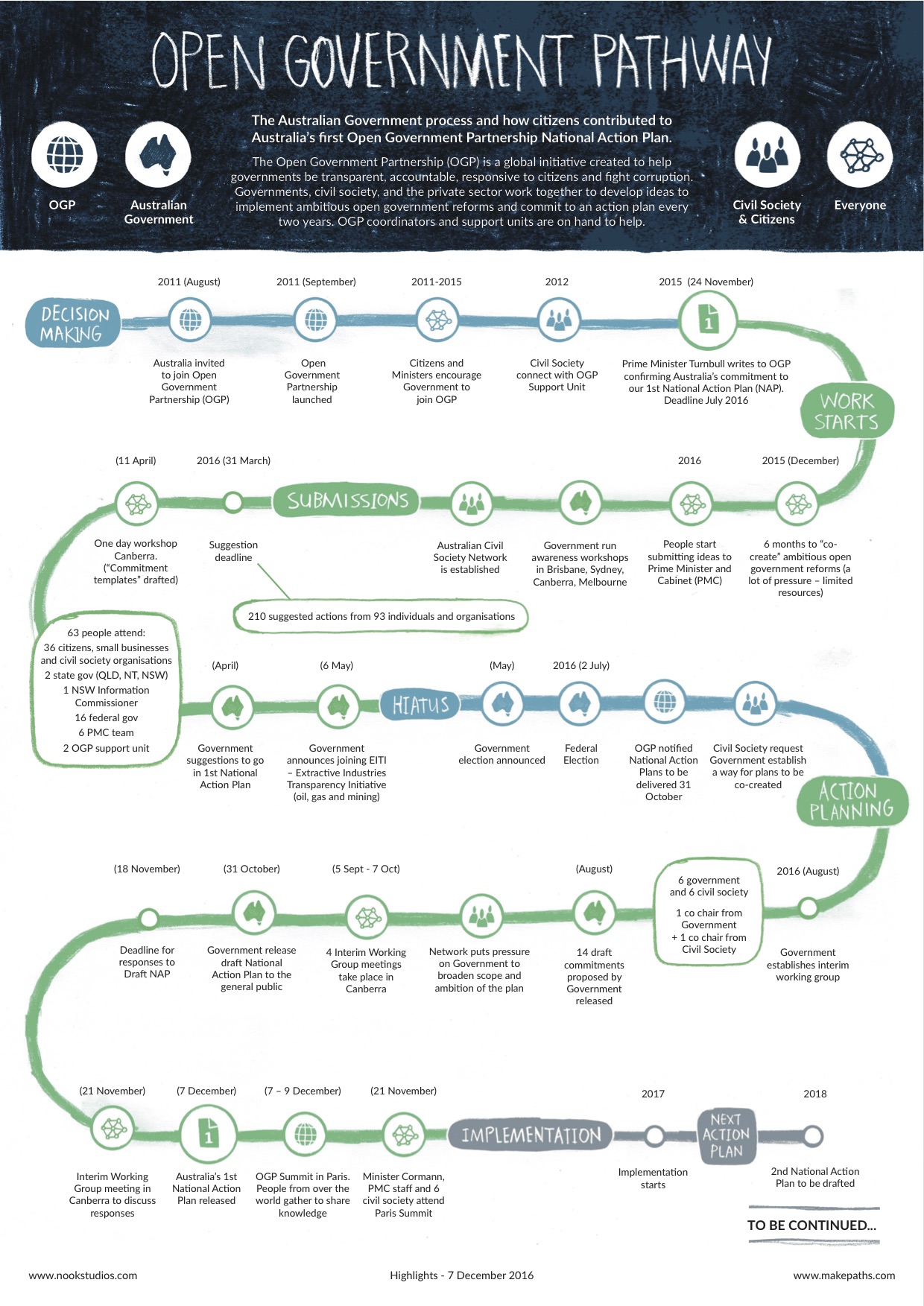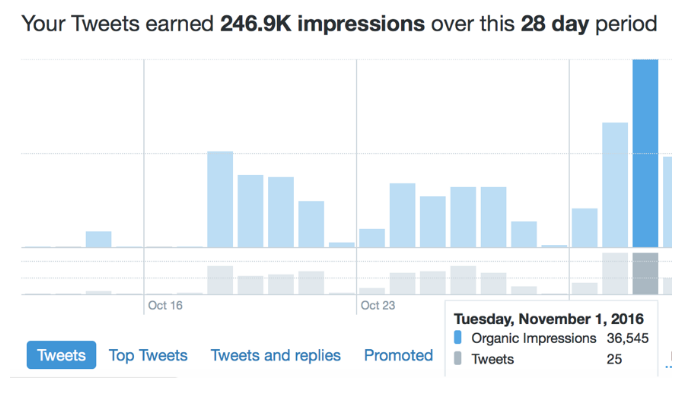Back in 2013 I tagged along invited myself to the Open Government Summit. At the time, I expected that Australia would officially announce we were joining the Open Government Partnership. At this summit in London, thousands of people from Civil Society and Government were working together on making life better for people in their countries.
The opening plenary session set the scene, the UK’s Special Minister for State, Francis Maude, addressed a packed hall of people from Government and Civil Society together, leading on “ Transparency is an Idea whose Time has Come”.
I hadn’t ever heard such a solidity to those words before. I saw and heard arguments made so very clearly of the benefits to people, to societies and even to economies. He presented Open Government Partnership as a truly an international platform that could elevate expectations from Government and of Civil Society.
Australian didn’t show up for Open Government that day. In the midst of positive energy and a throng of high level political support on show, I can’t say I wasn’t a little disappointed.
The British Prime Minister and outgoing Government OGP co-chair David Cameron went on to share “you can now map the crime of streets, the standards in your schools, the performance of your hospitals,you can see the businesses and people who Government meets with names and roles of senior civil servants, not to mention the pay of most of our top officials” before going on to announce yet more reforms, a couple of which we’re yet to dig into, including “a register of beneficial ownership that is open to the public” The Prime Minister clearly articulated the case for that register to be public. “Together we can close the door on shadowy corrupt practises.” he concluded.
And that was just the opening of the summit.
Three years and a change of Australian Prime Minister or three later, Malcolm Turnbull gave the fires of Open Government Partnership another little prod. It would take a bit more stoking than he seemed prepared to give it.
Without any big announcements or visible high level support, it was hard to imagine how a series of potentially transformative reform commitments would be crafted or co-created.
Why The OpenAustralia Foundation Dived In
We see OpenAustralia Foundation values aligned with the Open Government movement, and thought about how we could help in practical ways.
- Working with Government to extend the public servants’ comfort zones in the open Government space and encourage greater ambition. This includes:
- Helping people understand that the OGP is about practical improvements in people’s lives not just Open Government philosophy & largely about Open Data.
- Advocate that Government include commitments beyond the two themes they initially offered back in November 2017 and further out than Open Data alone. Those themes were:
- Improving public services
- More effective Use of Public Resources
In particular we saw a disconnect between perceptions of public integrity and the opportunities to improve accountability and transparency for public officials.
We came up with a goal that would express what we wanted to do & how we might go about it.
- Help create The Best Possible National Action Plan (NAP or The Plan) We’d aim to do this within the boundaries of that comfort zone, and maintain the integrity and spirit of the commitments as far as possible. Included in this is we aimed to promote clear communication of the plan, the commitments and opportunities for people.
- Look for ways to increase diversity of voices contributing to discussion, to increase interest and awareness in the Australian Open Government Partnership Network so that this group would get stronger, reflect a broader number of communities of interest, and for The Best Possible National Action Plan
The OpenAustralia Foundation worked as part of the independently formed Civil Society focussed Australian Open Government Partnership Network (AOGPN or ‘the Network’) interim self appointed Steering Committee. I put in an expression of interest and was both honored and flabbergasted to be invited to be one of six Civil Society members of the Interim Working Group (IWG or the Working Group). We’d participate alongside six senior public servants in meetings to discuss what would become Australia’s first Open Government National Action Plan. Between us, we reached out to Civil Society Organisations, individuals, business people, consultants and other non-government actors, the Government and the public to get input into and improve Australia’s first action plan.
Through the Working Group, Civil Society had a more formal opportunity to connect with each other as well as with Government, to work on these opportunities.
Now we can say that the Government presented a more ambitious plan following working with them, with greater scope and ambition than the Government initially proposed. However, commitments did not go as far as the reforms people who participated called for (see both the Manifesto and Wiki where the initial team at PM&C collected ideas).
Some things we did that were effective towards these goals
- We created a solid home for the Australian Open Government Partnership Civil Society Network online, a starting point for people to find out about the Open Government Partnership at opengovernment.org.au including brand ID, content design, strategy & delivery.
- Represented broad Civil Society interests, in the Working Group and Network Steering Committee
- Popularising use the words/concepts of Civil Society and participation which led into them being more acceptable in discussions and then into the action plan. Members of Network and others who initially shied away from the terms, then stood up for its use down the track, and these little words became part of IWG meeting vocabulary.
- Contributed substantially to two commitments on Participation
- Participation in Government decision making (we led this one)
- Including Ongoing Dialogue mechanism as a commitment
- Via membership of Interim Working Group and public submission
- provided input to specific commitments, including:
- OGP process on extending “trust” commitment including submission to OGP on privacy was effective. The commitment about trust now acknowledges that it’s not just about people misunderstanding, but that there are real privacy problems that need to be solved. Via submission/blog post and advocacy in IWG meetings.
- In all commitments:
- Advocated for Civil Society to be included and leading actors named as a starting point, to ensure this didn’t drop off as we got into the process of implementation (still working on it)
- provided input to specific commitments, including:
- Via membership of Interim Working Group, Questioning, “early and often”, assumptions made about how the process would run, what would be included. At the same time, working constructively and ‘picking battles’ to shift away from an inexorable slide to ‘business as usual’ with ‘the usual suspects’. This was a learning curve. It’s important this continue.
Making reforms easy to understand, and tell people about them
- We produced the Manifesto, an easy to read document, drew attention to reasons for each proposed reform, gave an outline in plain language, and explained the local context.
- This resource was reused and referred to by the Government, and their consultant for engagement, both Government and Civil Society members told us that they found this immensely useful. I don’t think the volume of people looking at this document online reflects the influence and interest reported to us. We can look at how many of the proposal from the Manifesto into The Plan, but not establish causal correlation.
- Helped other Civil society members of OGP understand the need to talk about this work from community’s perspective.
- Led language used, so it’s easier for people to understand
- We started the last phase of the OGP engagement process with a question: How do we make these commitments the best they can be?
- Encouraged and supported Network/Steering committee/Working group members to write and share through the Network blog on important and potentially transformative commitments.
- Ran Social media awareness/engagement campaign to make the most of short window of opportunity presented at short notice, for 2 week public input to the plan.
Social Media: Twitter Report
At the start of October 2016 the @opengovau had around 130 followers. By mid December 2016 @opengovau had over 400 followers.
When compared to other main social media influencers on the issue of the Open Government Partnership, @opengovau was ranked in the top ten influencers, ranking two spots below @opengov, a Twitter account run by the U.S. State Department. This was despite @opengovau having less than 1/8th the social media followers than any other account in the top ten group of social media influencers on the Open Government Partnership in October 2016.
https://twitter.com/Asher_Wolf/status/807080165352161280
Between October and November 2016, the @opengovau received 246.9k impressions over a 28 day period. The number of people visiting the @opengovau profile rose by 963.2%.
We learned something about Relationship Building for Practical Outcomes
When we had the first Network meeting, at least one person involved said they couldn’t see the point of the OGP, and many other people just ignored it. A year later, they were among a still small but more diverse group of voices and interests, expressing frustration and interest passionately with “why am I only finding out now?” or “why didn’t I know about this?” via twitter. Some of those we reached later in the piece contributed to formal process and others didn’t. It’s important to pick up with those who expressed an interest and understand how they might get stay actively interested and get involved in future.
- On twitter, website, discussions, public information sessions acted as trusted Civil Society conversation facilitator, and occasional interpreter and peace-keeper.
-
-
- Turning up and engaging was huge factor – if we don’t do it, then who is going to? How would this have looked if we hadn’t?
-
- Staying publicly calm and working with and through tensions in Civil Society, staying the course with Government, Civil Society and public. By working positively with the passions of complainants, a couple of complainants were moved to become contributors to the action plan. Win!
-
We learned that some things we did that weren’t so effective, and identified areas to work on if and when we continue this work. Fortunately this is an iterative process, and includes lots of scope for reflection, learning and iteration.
- I (Kat) didn’t write down what the aim of the project was and blog this at the very beginning.
- Some outside the Network were not aware of the rules of joining the Network and so thought there weren’t any. Great feedback for an organisation promoting accountability.
- Group discussion platform wasn’t widely used. We set up discussion groups around themes that were then not used very much. Nominated discussion leaders didn’t lead or discuss the issues widely, or invite others to participate publicly to any great extent- what would it take for that to change?


One Trackback
[…] a member of the Network Steering Committee and the PM&C Interim Working Group has written an account of her involvement and that of her colleagues Henare Degan and Luke Bacon in the twists and turns […]